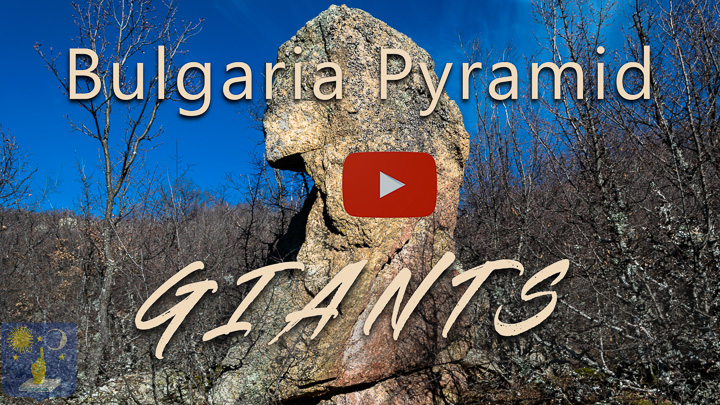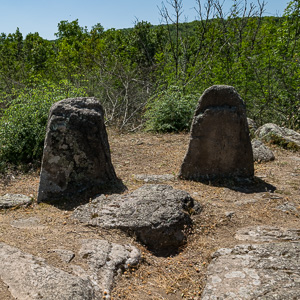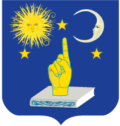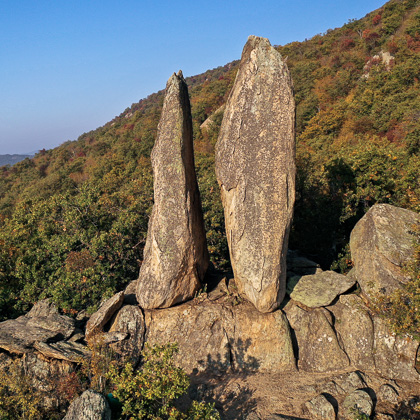Who else would build such huge edifices?
But maybe there is an alternative view.
At megalithic sites across Bulgaria we find standing stones that look like statues of giants petrified in time.

At the stone circle of Dolni Glavanak we seem to be witnessing a powwow, an assembly of wise elders, that has been petrified in order to be preserved in time.
In the Middle Mountain single megaliths seem to be leaning back like sunbathers to absorb the Sun. They have both anthropomorphic and cosmic qualities.
The columns of Slanchevo look like totems. The random layout gives the impression of a memorial overlooking the ancient seashore of the Black Sea.
There is a connection between time and stone, memory and megaliths.
The undulating sinews of clusters of megaliths in Rozovets remind us of the ridges and grooves of the brain, the internal storage of memory in modern Man.
The seemingly randomness of the lines dotted by clusters that act as nodes reminds of the structure of the human nervous system. It could also be interpreted as an artistic impression of how thoughts just pop into our heads to trigger a string of associations. There is a pattern but as in psycho-analytics we can only interpret them.
Rudolf Steiner reminds us that during this first epoch of humanity held memory was held not within, but without.
In the series of lectures: World History and the Mysteries, Rudolf Steiner refers to the Lemurians and early-Atlanteans as developing memory externally as opposed to internally. Memory was not located in the brain as it is today. Early humans had not reached that stage of evolution.
Everything of the nature of memory was connected to the setting up of signs and memorials on the Earth. p.9
Memory was maintained in external objects.
Lemurians and early-Atlanteans could fashion rock matter to fit their purpose, one of which was to use it as an external repository of memory.
The Lemurian [..] understood plants and animals in their inner action and life. He even understood the physical and chemical forces of lifeless objects in the same way. p.70
The Lemurian had the capacity to transform the natural stone into a composite material to fit his purpose.
[…] in man the forces of nature changed into forces of the will. He himself could thereby execute what nature accomplishes. p.73
Interestingly, Lemurians and early-Atlanteans interacted with stone in a similar way that we today safeguard our memory in silicon-made, digital hard drives.
Lemurians and early-Atlanteans were the first epoch of humanity to experience the I AM, a consciousness of the self. They experienced the early stages of development of consciousness without language as such and words to designate objects.
But with consciousness and thought comes death. So maybe these megaliths tell us about humanity’s first encounter with mortality. I am now but maybe not tomorrow. With consciousness comes death and the desire to remember and be remembered by later generations. The futile dream to beat time.
This would mean that the stone statues that ornate our cities today and the pyramidal-obelisk shaped memorials to the fallen are a legacy of the first brushes of humanity with consciousness, time and mortality.
Through time and the evolution of consciousness there is continuity in our relationship to the self and the loss of self through death. And we try to save our memories in stone, most often granite, to reconnect with the universal repository of knowledge, known as the Akasha Chronicle.
The megaliths are giants in the form of their memories stored in stone.

Transcript of the documentary on the Sun at the pyramids of Bulgaria
Giants are to pyramids what bricklayers are to houses.
Giants have often been associated with pyramids. Who else could build such huge edifices with such massive granite blocks?
But, maybe there is an alternative view…
Talking to stones… and listening to the giants of Bulgaria.
Subscribe below to learn more about the cosmic origins of humanity.
In Bulgaria we find standing stones that look like statues of giants petrified in time.
At the stone circle of Dolni Glavanak we seem to be witnessing a powwow, an assembly of elders, that has been preserved in time.
The columns of Slanchevo look like totems. The random layout gives the impression of a memorial overlooking the ancient seashore of the Black Sea that was flooded.
And in the Middle Mountain single megaliths look like giant sunbathers leaning back to absorb the Sun. The stones have both anthropomorphic and cosmic characteristics.
There is a connection between time and stone, memory and megaliths.
On our website we have dedicated articles and upcoming videos on this topic. Subscribe below to be notified.
The undulating sinews of clusters of megaliths in Rozovets remind us of the ridges and grooves of the brain, the internal storage of memory in modern Man. But here the memory is stored externally.
The seemingly randomness of the lines dotted by clusters that act as nodes reminds us of the neurological system. It is like an artistic impression of the way thoughts pop into our heads triggering a string of associations. But as in psycho-analytics we can only interpret the patterns but not replicate them. It is something bigger than us.
Rudolf Steiner gives us an explanation. During this first epoch of humanity memory was held not within, but without.
In the series of lectures: World History and the Mysteries, Rudolf Steiner refers to the Lemurians and early-Atlanteans as developing memory externally as opposed to internally. Memory was not located in the brain as it is today. Early humans had not reached that stage of evolution.
Everything of the nature of memory was connected to the setting up of signs and memorials on the Earth. p.9
Memory was maintained in external objects.
It was a time of humanity when the soul was still not integrated in the body. It stayed outside, in front of the physical body. Till today we have memorized this epoch in tales and images of the body of a beast with the soul of an angel. It is symbolized in the unicorn that has a protruding horn.
And the art of the Bulgarian megaliths tell us a similar story of large protruding stones that capitate the edifice. It is the same concept as the unicorn only expressed in a more abstract, less detailed manner.
Lemurians and early-Atlanteans could fashion rock matter to fit their purpose, one of which was to use it as an external repository of memory.
The Lemurian [..] understood plants and animals in their inner action and life. He even understood the physical and chemical forces of lifeless objects in the same way. p.70
The Lemurian had the capacity to transform the natural stone into a composite material to fit his purpose.
[…] in man the forces of nature changed into forces of the will. He himself could thereby execute what nature accomplishes. p.73
Interestingly, Lemurians and early-Atlanteans interacted with stone in a similar way that we today safeguard our memory in silicon-made, digital hard drives and fashion statues from granite.
Lemurians and early-Atlanteans were the first epoch of humanity to experience the I AM, a consciousness of the self. They experienced the early stages of development of consciousness. There was no language as such and no words to designate specific objects.
We have a separate video on WHO built the pyramids that touches on this topic. There is a link below.
But with consciousness and thought comes death. So maybe these megaliths tell us about humanity’s first encounter with mortality. I am now but maybe not tomorrow. So maybe this art is the first expression of the desire to be remembered.
This would mean that the stone statues that ornate our cities today and the pyramidal-obelisk shaped memorials to the fallen are a legacy of the first brushes of humanity with consciousness, time and mortality.
Through time and the evolution of consciousness there is continuity in our relationship to the self and the loss of self through death. And we try to save our memories in stone, most often granite, to reconnect with the universal repository of knowledge, known as the Akasha Chronicle.
The megaliths are the giants in the form of their memories stored in stone.
You are welcome to help us decipher the message held in the stones by participating in the Bulgaria Pyramid Project. There is a link to our website in the description below. Together we will find more connections to establish patterns between the stars and the pyramids.
Subscribe to our channel to be notified of the next videos on the pyramids of Bulgaria.













